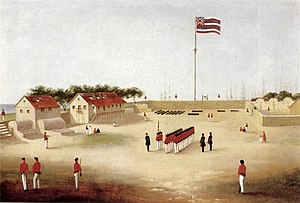French Invasion of Honolulu
| French Invasion | |||||||
|---|---|---|---|---|---|---|---|
 Honolulu Fort, 1853 |
|||||||
|
|||||||
| Belligerents | |||||||
|
|
|
||||||
| Commanders and leaders | |||||||
|
|
|
||||||
| Strength | |||||||
| 1 frigate 1 corvette 140 Marines |
1 fortress | ||||||
French tactical victory; strategically insignificant
The French invasion of Honolulu (also known as the Sacking of Honolulu, or the Tromelin Affair) was an attack on Honolulu by Louis Tromelin in retribution for the local persecution of Catholics and repression of French trade.
On August 12, 1849, French admiral Louis Tromelin arrived in Honolulu Harbor on the corvette Gassendi with the frigate La Poursuivante. While in Honolulu, De Tromelin found out about the past persecution of Catholics and the high tariffs on French brandy from French Consul William Patrice Dillon, who oversaw French interests in Hawaii. De Tromelin, angered by the ABCFM missionaries’ intention to shut out Catholicism and French trade, made ten demands to King Kamehameha III on August 22.
The demands had not been met by August 25. After a second warning to the civilians of the impending invasion, 140 French Marines, two field pieces, and scaling ladders were landed by boat. The marines overwhelmed and captured Honolulu Fort from the two men defending it, Governor of Oahu Mataio Kekuanaoa and Marshal of the Kingdom Warren Goodale, who did not resist, the fort having been evacuated before the French landed. The marines spiked the coastal guns, threw kegs of powder into the harbor and destroyed all the other weapons they found (mainly muskets and ammunition). They raided government buildings and general property in Honolulu, causing $100,000 in damages. They also took the king's yacht, Kamehameha III, which was sailed to Tahiti and never returned. After these raids, the invasion force withdrew to the fort. During the occupation, men in Honolulu ridiculed the French, and on August 30 they organized a mock attack party making the marines double their guard and send skirmishing patrols out late into night, encountering no attackers. De Tromelin eventually recalled his men and left Hawaii on September 5.
...
Wikipedia
